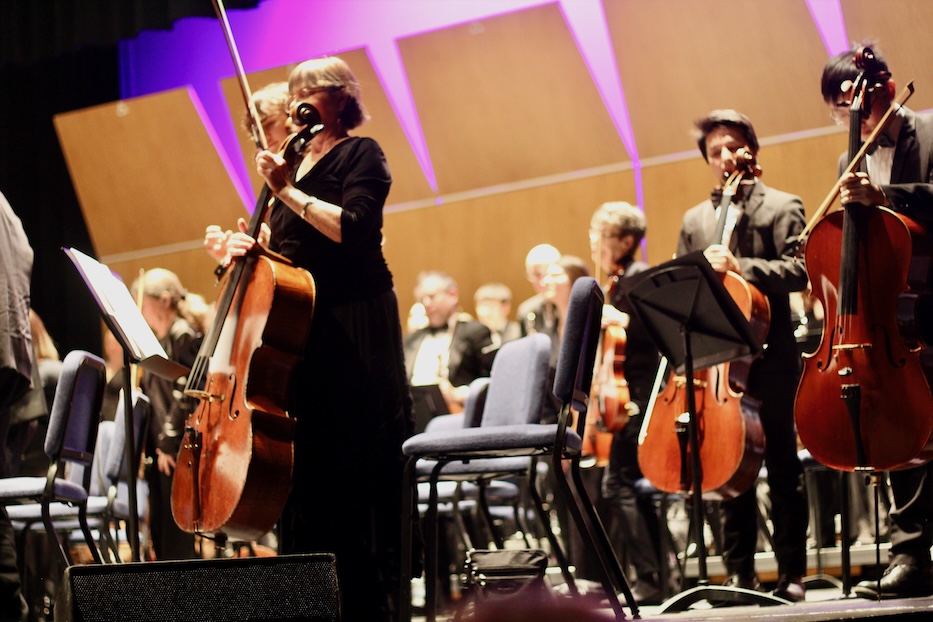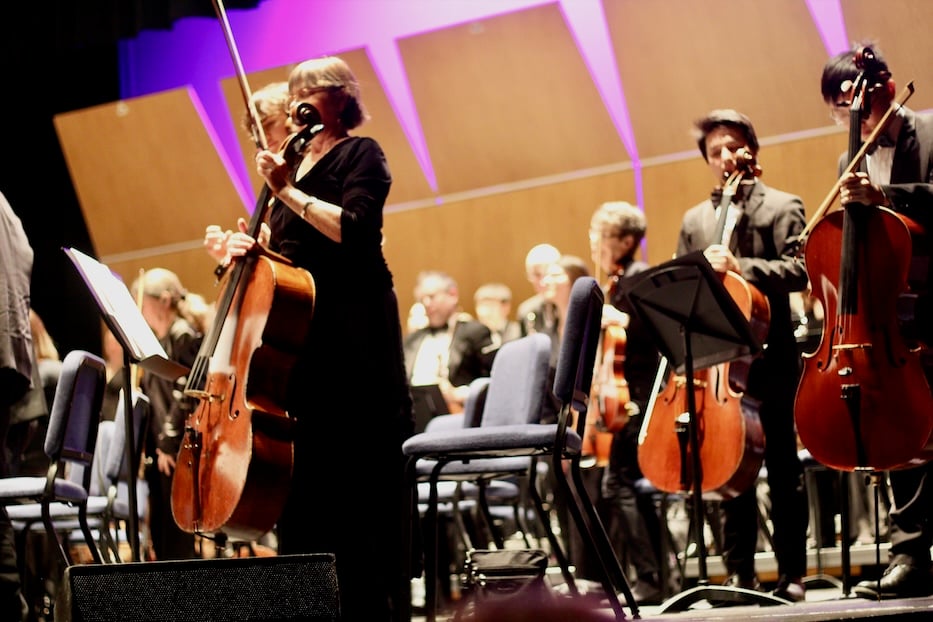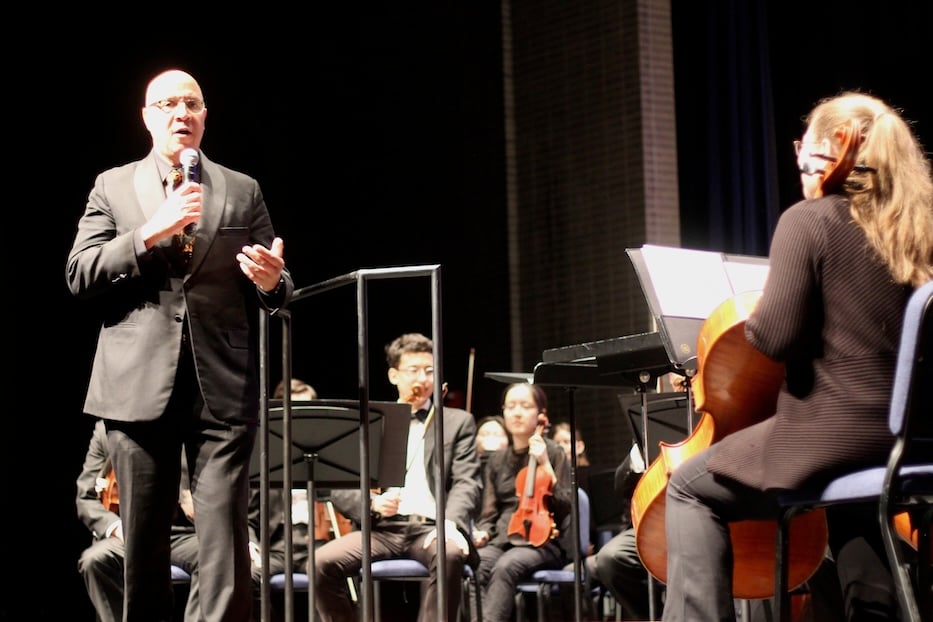
Culture & Community | Music | Arts & Culture | New Haven Symphony Orchestra | Arts & Anti-racism

Lucy Gellman Photos.
On the podium, Chelsea Tipton was taking it back to the 1920s. Timpani rang out across the auditorium, filling every empty space with their chest-rattling boom. They undulated, persistent, on the precipice of something. Horns slipped in, buttery smooth, then picked up the pace. In the audience, toes began to tap. Heads bobbed and shoulders shimmied. The party had started, and it was sizzling hot.
It was just one of the ways that the New Haven Symphony Orchestra (NHSO) tapped into a kind of rare, explosive, and at times sacred joy at “Harlem Renaissance: Orchestral Voices,” presented last weekend at the John Lyman Center for the Performing Arts at Southern Connecticut State University. Throughout the afternoon, it made clear what an imprint the period has left on American history—and what a profound debt musicians owe the Black composers, often overlooked and underplayed, who stewarded it.
The afternoon included works from James P. Johnson, Margaret Bonds, William Grant Still, Duke Ellington and Carlos Simon. In a lineup that felt both soul-stirring and celebratory, Principal Pops Conductor Chelsea Tipton also welcomed soprano Lisa Williamson and Christian Sands, an ECA grad who is now a Grammy-nominated artist.
“The Harlem Renaissance was such an important period,” Tipton said. “It was a rich coming together of artists of all genres—poets, dancers, visual artists, musicians—coming together to share their crafts with one another, inspire one another.”
Spurred by the Great Migration and the First World War, the Harlem Renaissance marked a flourishing of Black creativity that remains one of the most significant in 20th-century American history. Working across media, artists both celebrated and documented Black culture, with an outpouring of work that includes now-household names (W. E. B. Du Bois, Langston Hughes, Jacob Lawrence, James Van Der Zee) and dozens of lesser-known ones, like Augusta Savage, Mae Cowdery, and George Henderson.
Too often, Tipton noted, history has failed to credit the period’s musical voices properly. There are, for instance, strong suggestions of Johnson’s 1932 “Drums” in Aaron Copeland’s “Fanfare for the Common Man,” which became one of the most-performed works of the 20th century but was written a decade later. Or in Johnson’s “Yamekraw: An Ebony Rhapsody,” one hears a conversation with George Gershwin’s “Rhapsody In Blue,” yet the latter gets far more airplay than the former.
Maybe for that reason, the concert became a cause for celebration, Tipton's warmth effusive and radiating from the stage. As he cued up Johnson’s “Drums,” applause rose preemptively, conversations falling silent across the dark space. On stage, bars of tympani hammered and rolled, as if to mark the official beginning of the afternoon.
The work, which was part of Johnson’s Harlem Hotcha, marries full, rolling percussion with infectious, danceable brass, until the whole piece is brimming with sound. As the symphony played, members of the audience began to respond, making the auditorium feel cozier, intimate.
Yes! came a woman’s voice from somewhere in Row G. Alright! another murmured at stage left, and trombones Lindy Hopped around each other in a dizzying burst of light. It had been less than 10 minutes, and already the audience was traveling through time and space, hurdling back to 1920s Harlem. The only thing missing, it seemed, was a dance floor.
Moments later, Williamson showed off the great variety of the period, as well as some of its still underrepresented voices. Taking the stage, she introduced the audience to Margaret Bonds, a pianist and composer who grew up surrounded by cultural luminaries, and made history at just 19, when she soloed with the National Symphony Orchestra. At the time, it was a rare feat for any Black artist, and rarer still for a young Black woman.
But Bonds personified what it meant to defy the dominant narrative. By 20, she was a soloist with the Chicago Symphony Orchestra, astounding audiences with John Alden Carpenter’s “Concertino” in 1933. Those years also included the symphony’s premiere of Florence Price’s “Symphony In E Minor,” giving voice to one of Bonds’ teachers and musical foremothers who was also a Black woman struggling to achieve recognition.

Principal Pops Conductor Chelsea Tipton, who has been with the NHSO for a decade.
“Her [Bonds’] real love was in composition, and particularly classical settings of spirituals and original art songs,” Williamson said, her butter-yellow dress glowing in the light. “Usually by poets of the Harlem Renaissance, particularly one of her good friends, Langston Hughes.”
“She considered herself as a link between previous generations of African Americans who valued the traditional history and folksong and spirituals of their past, and the modernity of the 20th century,” she added.
The audience didn’t have to wait long to see—and hear—what she meant. When she launched into Bonds’ sweeping arrangement of “Hold On,” Williamson transformed into something superhuman, her whole body moving with the words as her eyes took on a fiery resolve. Keep your hand on that plow — behind her, strings enveloped the audience, spilling over the stage — Hold on!
Hold On! She sang the words, and hand extended into the darkness in front of her, as if finding the way forward. Hold Ooo-oo-n! A listener could feel something tugging and heavy just behind the sternum, full of conviction and certainty in a world turned completely on its head.
It was the kind of music meant to be felt with a person’s whole body, their whole being. When Williamson started “I Got A Home In That Rock,” she let the arrangement carry her somewhere that wasn’t quite New Haven, and wasn’t not New Haven either, aware of a presence greater than herself and the audience. Out in the darkened auditorium, attendees could feel it too, a history of resilience pulsing in the space between the words.
By the time she concluded with “He’s Got The Whole World In His Hands,” her voice swelled with emotion, and a listener could feel like they were inside of it, riding a gentle wave as it crested in the auditorium. Cheers of “Brava” and “Magnifico!” rose from the front rows, and a look of wonder crossed the soprano’s face.
That excitement was still there, humming and electric, after she left the stage and Sands entered, ready to bring Johnson’s “Yamekraw: An Ebony Rhapsody” to New Haven. Horns came in, triumphal but not bellowing, and Sands responded instantly, willing a cascade of piano beneath his fingertips. They nudged back, and Sands built on their swirling melody. A chime sounded in the distance, dazzling, and musicians jumped into jaunty, jazz-kissed orchestration with piano at the center.
The curtain of sound parted, and Sands was on fire, his whole body alive with the work. Three minutes in, and he had a whole conversation with the trombones. Clarinet dipped and twirled coquettishly, and keys danced in delight as they took over. No wonder people in the audience had started responding by then: this back-and-forth begged for reaction, too molten and propulsive for a buttoned-up crowd.
Sands’ face meanwhile, a study in the act of close listening, made it impossible to look away. Flute responded to a clamor of horns, and Sands sucked in his bottom lip, scowling in the way one does when something is too exquisite and delicious to do anything else. Trombones skittered and swayed, and he watched the section so intently it seemed that he could see the sound itself. Someone made a throaty, near-growling sound of appreciation at stage right, and it was as if they had given voice to the piece. Back onstage, Sands' eyes danced and gleamed, at once a part of and apart from the orchestra.
That exuberance flowed through the remainder of the concert, from Carlos Simon’s rousing, contemporary “Amen” (“He’s not a decomposer,” Tipton said to laughs from the audience) to Duke Ellington’s “Black, Brown and Beige.” But nowhere was it clearer than the third movement of William Grant Still’s Symphony No. 1, as Tipton turned around in a starburst of sound, and got the audience clapping in time with the music. When they finished, bows suspended in the air, some audience members leapt to their feet.
It also marked a milestone: Tipton has been with the NHSO for a decade, conducting dozens of concerts during that time. To honor that commitment, the organization’s board has voted to name its Harmony Fellowship for Underrepresented Musicians after him for the next decade. As Board President Keith Churchwell announced the news, Tipton clasped his hands in surprise, beaming and verklempt all at once.
“It’s been such an honor and a pleasure to work with these amazing musicians here,” he said before returning to the program. “They do so much to bring great music to you all from the stage here, but also so much in the community as well. And arts organizations, we have to reach out to the community.”
“Thank you for 10 great years,” Churchwell said. “We look forward to the next 10.”

